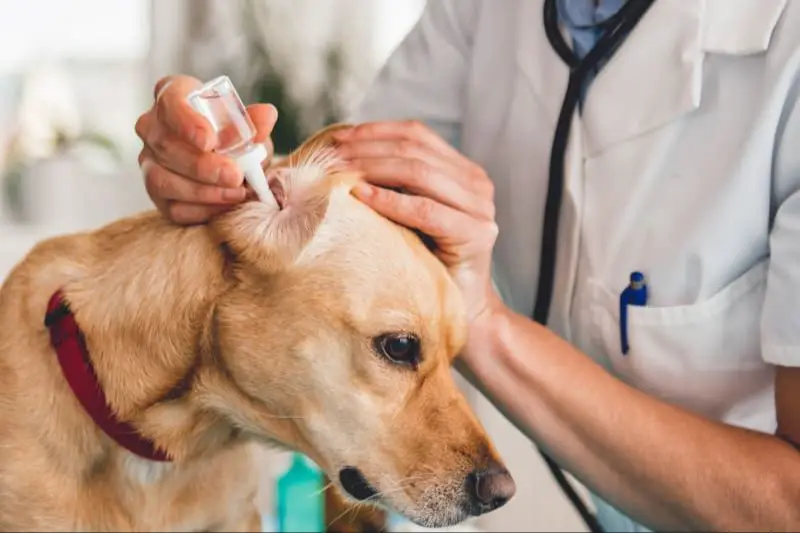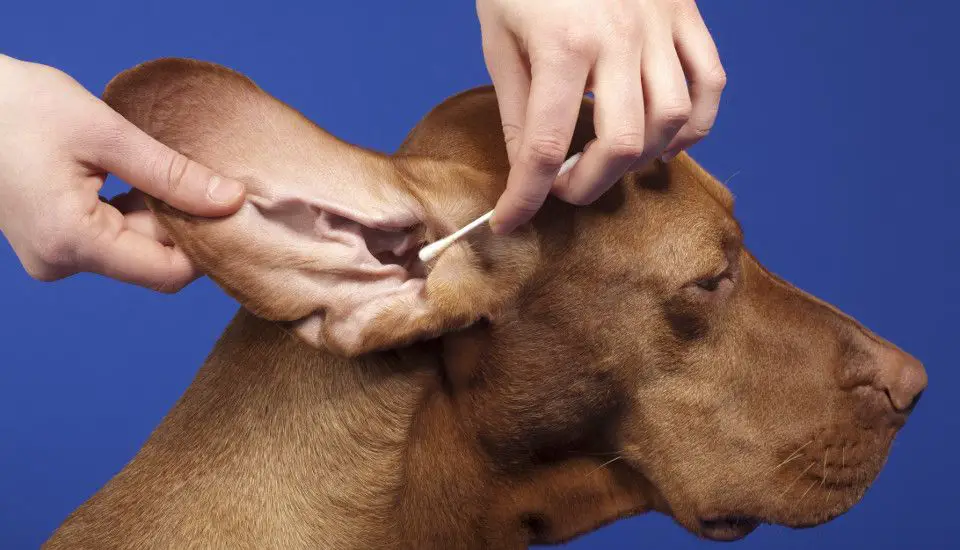The Agony of Fido’s Ear Infection
“Oh no, not again!” you sigh as your dog Fido shakes his head violently and scratches at his ear. That familiar stench hits your nose and you realize it’s happening – another ear infection. As frustrating as they are, ear infections are very common in dogs, affecting an estimated 20% at some point in their lives. Let’s get to the bottom of what’s causing Fido’s agony and explore whether antibiotics are always necessary.
Symptoms
Ear infections in dogs exhibit several common symptoms. The most noticeable sign is head shaking and ear scratching. Your dog will shake their head and scratch at their ears more frequently as they try to relieve irritation and discomfort. Redness and swelling inside the ear canal is also common. You may see discharge in the ears that can be waxy, bloody, or purulent. This discharge often has a foul odor. Dogs with ear infections also experience increased sensitivity in the affected ear. They may yelp or cry if the ear is touched due to tenderness and pain.

Causes
There are several common causes of ear infections in dogs:
Allergies – Allergies to foods, medications, grass, pollen, or other substances can cause inflammation and swelling in the ear canal, leading to infection. The inflammation blocks the ear canal, trapping moisture inside.
Foreign objects – Objects like grass seeds, dirt, burrs, or small sticks can get lodged in the ear canal and cause trauma, irritation, and infection. Dogs with heavy, hanging ears like Cocker Spaniels are prone to this.
Excess moisture – Moisture in the ears from swimming, bathing, excessive ear wax, or other sources can lead to yeast and bacterial overgrowth. The warm, moist environment promotes infection.
Bacteria and yeast – Common bacterial infections include Staphylococcus, Pseudomonas, and Proteus species. Yeast infections are typically caused by an overgrowth of Malassezia. These organisms are normally present in small numbers but can multiply and cause infection.
Diagnosis
To diagnose a dog ear infection, veterinarians will first perform a physical exam of the ear canal using an otoscope to look for signs of inflammation, discharge, or foreign objects lodged in the canal. They will also take note of any odor coming from the ears, as foul smelling discharge can indicate an infection.
The next step is to take a sample of the discharge from the ear canal to examine under a microscope. This helps identify the type of microorganisms causing the infection, such as bacteria, yeast, or mites. The veterinarian will look for an abnormally high number of microorganisms as well as any parasitic mites.
In some cases, the vet may recommend taking a culture and sensitivity test of the discharge to identify the specific species of bacteria or yeast involved. This helps determine which medications will be most effective at targeting the infection.
The physical exam along with the microscopic analysis of the ear discharge enables the vet to diagnose the type of infection (bacterial, fungal, parasitic) as well as pinpoint the underlying cause, such as allergies, hypothyroidism, or autoimmune diseases. This is important in order to treat both the infection and its root cause.
Treatment Options

Ear infections in dogs have several treatment options depending on the cause and severity. Some options for treating ear infections include:
Cleaning and Drying the Ear
Keeping the ear clean and dry can help prevent and treat early infections. Gently wipe out debris with a cotton ball soaked in an ear cleanser recommended by your veterinarian. After bathing your dog, thoroughly dry the ears since moisture trapped inside can allow yeast and bacteria to thrive.
Medicated Ear Drops
For bacterial and fungal infections, vets often prescribe antibiotic, antifungal, and steroid-containing ear drops to treat the infection and reduce inflammation. It’s important to administer drops as directed and gently massage the base of the ear after application.
Oral Antibiotics
For severe bacterial infections that have spread beyond the external ear canal, vets may prescribe oral antibiotics to clear the infection. Antibiotics may be needed for 6-8 weeks. Always finish the full course as directed.
Anti-inflammatories
Steroids and non-steroidal anti-inflammatory drugs (NSAIDs) can help reduce swelling, irritation, and pain caused by ear infections in dogs. This provides relief while other treatments address the underlying infection.
Allergy Management
Since allergies are a common cause of chronic ear problems in dogs, managing allergy symptoms can prevent recurrent infections. This may include medications, hypoallergenic diets, and avoiding allergy triggers.
When Antibiotics Are Needed

Antibiotics are often necessary for treating severe, chronic or recurring ear infections in dogs. Ear infections that are not resolved on their own or with routine cleaning and medication generally warrant antibiotic treatment. This is especially true if examination of the ear drainage reveals the presence of rod-shaped bacteria (rods) or spherical bacteria (cocci), which can signal a bacterial infection.
Additionally, antibiotics may be prescribed if the infection shows signs of spreading from the outer ear to the inner ear or adjacent tissue. Some of the spread indicators include head tilting, lack of balance, swelling of lymph nodes, fever and lethargy. Allowing the infection to spread increases the risk of permanent damage to structures of the ear. Therefore, antibiotics help stop the infection from advancing further.
In summary, vets typically recommend antibiotic therapy for canine ear infections that are severe, chronic or recurrent in nature, contain specific types of bacteria, or show signs of spreading beyond the external ear canal. Prompt antibiotic treatment can halt the infection and prevent further complications.
When Antibiotics Aren’t Needed
Antibiotics are generally not needed in cases of mild, localized ear infections with no swelling or other concerning symptoms. Many ear infections, especially first occurrences, are caused by viruses or yeasts and will often clear up on their own. Since antibiotics only kill bacteria, they are ineffective against viral and fungal infections.
For mild ear infections that seem localized and aren’t causing systemic symptoms, it’s often best to hold off on antibiotics. Watchful waiting for a couple days may allow the infection to resolve without medication. Using an analgesic eardrop can provide pain relief during this period.
Additionally, antibiotics are not warranted if a culture shows yeast but no pathogenic bacteria. Yeast is not affected by antibiotic treatment, so using antibiotics would be ineffective and only increase the risk of side effects or antibiotic resistance.
In summary, antibiotics are generally not needed for mild, localized first-time ear infections, especially when caused by viruses or yeast. It’s reasonable to wait a day or two to see if symptoms resolve on their own before pursuing antibiotic treatment.
Risks of Overusing Antibiotics
Overusing antibiotics when treating ear infections in dogs can lead to some significant health risks. The most concerning issue is antibiotic resistance. When antibiotics are used too often, bacteria can adapt and become resistant to the medication. This makes future infections much harder to treat.
Antibiotics also kill off beneficial bacteria in the gut. The loss of good bacteria can allow harmful bacteria to multiply, resulting in gastrointestinal issues like diarrhea, vomiting, or loss of appetite. The imbalance of bacteria may also diminish the immune system.
Finally, dogs that receive frequent and/or unnecessary antibiotics have an increased susceptibility to developing future infections. Since antibiotic use can wipe out protective bacteria and weaken the immune system, dogs may be more prone to picking up new illnesses and infections.
Prevention
There are several things dog owners can do to help prevent ear infections in their pets:
Keep ears clean and dry: Check and gently wipe your dog’s ears weekly. After baths or swimming, thoroughly dry your dog’s ears. This removes debris and moisture that can breed bacteria and yeast.
Control allergies: Allergies to food or environmental factors like pollen can cause inflammation that leads to infection. Work with your vet to identify and manage any allergies your dog may have.
Avoid foreign objects: Don’t let your dog stick foreign items like sticks or grass seeds into their ears, which can cause scratches or wounds vulnerable to infection.
Conclusion

To recap the key points, ear infections in dogs are usually caused by bacteria or yeast, but identifying the exact cause requires a veterinarian’s exam and tests. Some mild cases may resolve on their own, while others require medication. Antibiotics are an effective treatment but should be used judiciously, as overuse can lead to antibiotic resistance.
Not all ear infections require antibiotics. For mild cases, your vet may recommend cleaning the ear and applying medication to soothe inflammation and fight infection. They may take a wait-and-see approach before prescribing antibiotics. More severe cases usually do warrant antibiotics.
Work closely with your veterinarian to determine the best treatment for your dog’s ear infection based on the cause and severity. Together you can decide if and when antibiotics are needed to support your dog’s health and comfort.